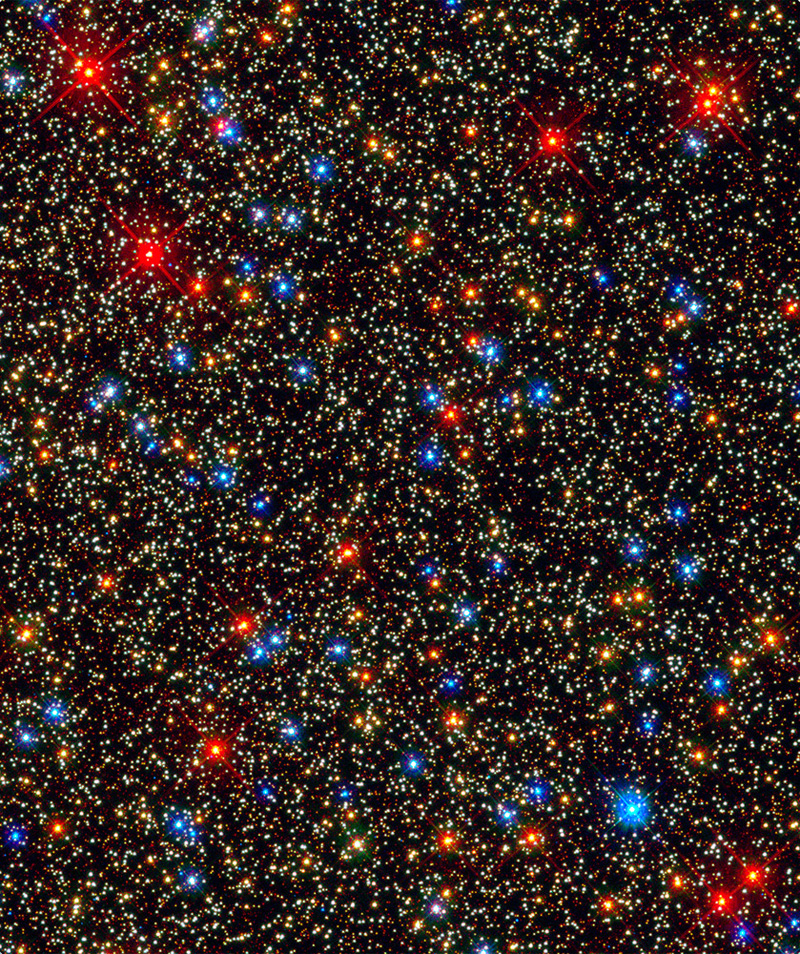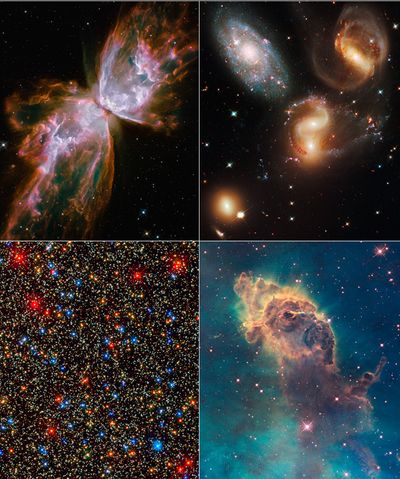Spectacular First Images from the Rejuvenated Hubble Space Telescope
September 9, 2009: Astronomers have declared NASA's Hubble Space Telescope a fully rejuvenated observatory with the release of observations from four of its six operating science instruments. Sen. Barbara Mikulski of Maryland unveiled the images today at NASA Headquarters in Washington, DC.
"This marks a new beginning for Hubble," said Ed Weiler, associate administrator for NASA's Science Mission Directorate. "The telescope was given an extreme makeover and now is significantly more powerful than ever, well equipped to last into the next decade."
Topping the list of new views are colorful, multi-wavelength pictures of far-flung galaxies, a densely packed star cluster, an eerie "pillar of creation," and a "butterfly" nebula...
READ ON at Science@NASA
View the complete gallery at NASA.gov
Mike
(Thanks to Ken T.)
Featured Comment by Ken Tanaka: "Now this is an expensive camera upgrade!"





The new Leica M9 should easily outresolve these.
Posted by: Stephen Best | Wednesday, 09 September 2009 at 09:10 PM
Dammit. Going to be burning through a lot of black ink...
Posted by: Tom | Wednesday, 09 September 2009 at 09:46 PM
Mike,
Thanks for drawing our attention to these awe-inspiring images and the incredible technology that produced them. Looking at these is a great reminder that we should not lose focus (no pun intended) on the power of vision itself....maybe concentrate a little less on camera specs and pay more attention instead to what is out there to see. Thanks again!
Posted by: Catherine | Wednesday, 09 September 2009 at 10:04 PM
hopefully it wont fall apart like the previous attempts...I remember seeing a parody Hubble toy ad where the object was to keep it together..lol
Posted by: Constant Gina | Wednesday, 09 September 2009 at 10:14 PM
Very large format.
Posted by: Jeff | Wednesday, 09 September 2009 at 10:27 PM
"Looking at these is a great reminder that we should not lose focus (no pun intended) on the power of vision itself....maybe concentrate a little less on camera specs and pay more attention instead to what is out there to see."
Considering the Hubble's near sighted history I think they should keep their focus on the camera specs. It became a much more successful project once they did.
Posted by: Tom | Wednesday, 09 September 2009 at 11:03 PM
A very keen and pertinent observation, Catherine. Very keen indeed.
Posted by: Ken Tanaka | Wednesday, 09 September 2009 at 11:26 PM
As someone who works with Hubble data, I am willing to submit a hands-on review if Mike would want that :-)
The best thing about Hubble is its image-stabilisation: 3 gyroscopes. Good job it works so well seeing as many exposures can be as long as 1 hour.
And who said CAT lenses were no good?
Posted by: Miserere | Wednesday, 09 September 2009 at 11:38 PM
What do people have to say about software correction of lenses now?
Posted by: Ned | Wednesday, 09 September 2009 at 11:47 PM
Never mind all that infinite grandeur. Can we see a test chart, please?
Posted by: James McDermott | Thursday, 10 September 2009 at 12:05 AM
Hubble's back. Not so sure about Leica.
Posted by: stephen | Thursday, 10 September 2009 at 01:18 AM
Fantastic!
Just try to imagine what's out there.............
Posted by: Chris Gibbs | Thursday, 10 September 2009 at 01:53 AM
"It's full of stars!.."
:)
Posted by: Jacek Sztandera | Thursday, 10 September 2009 at 02:09 AM
Absolutely beautiful. Our universe never ceases to amaze.
Posted by: YS | Thursday, 10 September 2009 at 02:57 AM
Dear Tom,
No, Catherine had it right. The "lens" specs were just fine! It was the quality of the lensmaking that was inferior. Specs are all very nice, but they don't mean a damn thing if not backed by craftsmanship.
The "camera(s)" by the way, were fine in both spec and execution.
pax / Ctein
Posted by: ctein | Thursday, 10 September 2009 at 04:29 AM
Are those stars or noise?
Posted by: ronaldo | Thursday, 10 September 2009 at 07:19 AM
The fix wasn't in software, but with supplementary optics.
The story of how that telescope was launched with a misfigured mirror is an interesting one. As I understand it, a very simple and inexpensive test (the kind an amateur astronomer would use while making their own mirror), showed a likely flaw. A very expensive test with a custom-built gadget showed a perfect mirror. Guess which test the engineers believed? But, as it turns out, the expensive testing gadget had a problem.
I'm thrilled the Hubble has had a long and productive life. I wish we had five of them.
Posted by: Kevin | Thursday, 10 September 2009 at 08:02 AM
and who still thinks that we are alone in the universe?
Posted by: Kent Whiting | Thursday, 10 September 2009 at 08:10 AM
"Awesome" in the most literal sense.
But it does look like an early Pentax DSLR with its noise reduction turned off.
Posted by: Luke | Thursday, 10 September 2009 at 09:07 AM
Where are the cat pictures?
Posted by: Ken N | Thursday, 10 September 2009 at 10:24 AM
I'm not impressed. How fast is its autofocus? How many frames per second can this "Hubble" shoot?
;-)
Posted by: Mark Roberts | Thursday, 10 September 2009 at 11:12 AM
Great choice of comment to feature, Mike! This does rather put the "too expensive" discussion in perspective.
The Hubble is "too expensive" for me -- but I'm proud to contribute to funding it through tax dollars.
Kent, I'm more resigned to thinking we might be alone in the universe now than I was 40 years ago. As we get better and better instruments of various kinds, our ability to detect other civilizations goes up, and we still aren't finding them. (And I've been donating computer time to SETI@HOME since they started, too.)
Posted by: David Dyer-Bennet | Thursday, 10 September 2009 at 12:32 PM
Dear Kevin,
Your memory's good enough-- sloppy testing led to poor fabrication. A very classic example of the difference between 'precision' and 'accuracy.'
As for the fix, they used both. It was three and a half years before corrective optics could be installed. During that time, scientists used software to correct the residual spherical aberration very successfully.
Eventually, ALL high quality digital photograph-creation is going to involve some software "optical" correction. I won't put a date on that, but it's a sure thing. Like aspherical lens elements and high dispersion glasses, it's just one more tool in the lens designer's kit, and it's a good one.
pax / Ctein
Posted by: ctein | Thursday, 10 September 2009 at 01:53 PM
And how close can in focus in macro mode?
Posted by: Riley | Thursday, 10 September 2009 at 02:45 PM
Riley: Well, the ratio from closest focus to furthest object imaged is pretty good on this Hubble thing. It can focus down to a mere few million kilometers!
Posted by: David Dyer-Bennet | Thursday, 10 September 2009 at 03:53 PM
And does it do HDR or highlight tone priority.
Posted by: KeithB | Thursday, 10 September 2009 at 03:58 PM
Dear Riley,
Oh, about 180 light-seconds, but its depth of field is excellent!
pax / Ctein
Posted by: ctein | Thursday, 10 September 2009 at 08:57 PM
I don't know...there's a lot of blue and red CA there, and it seems really grainy...lots of shiny dots all over. I really expected more from a full frame hubble....
Posted by: Dan States | Sunday, 13 September 2009 at 05:25 PM